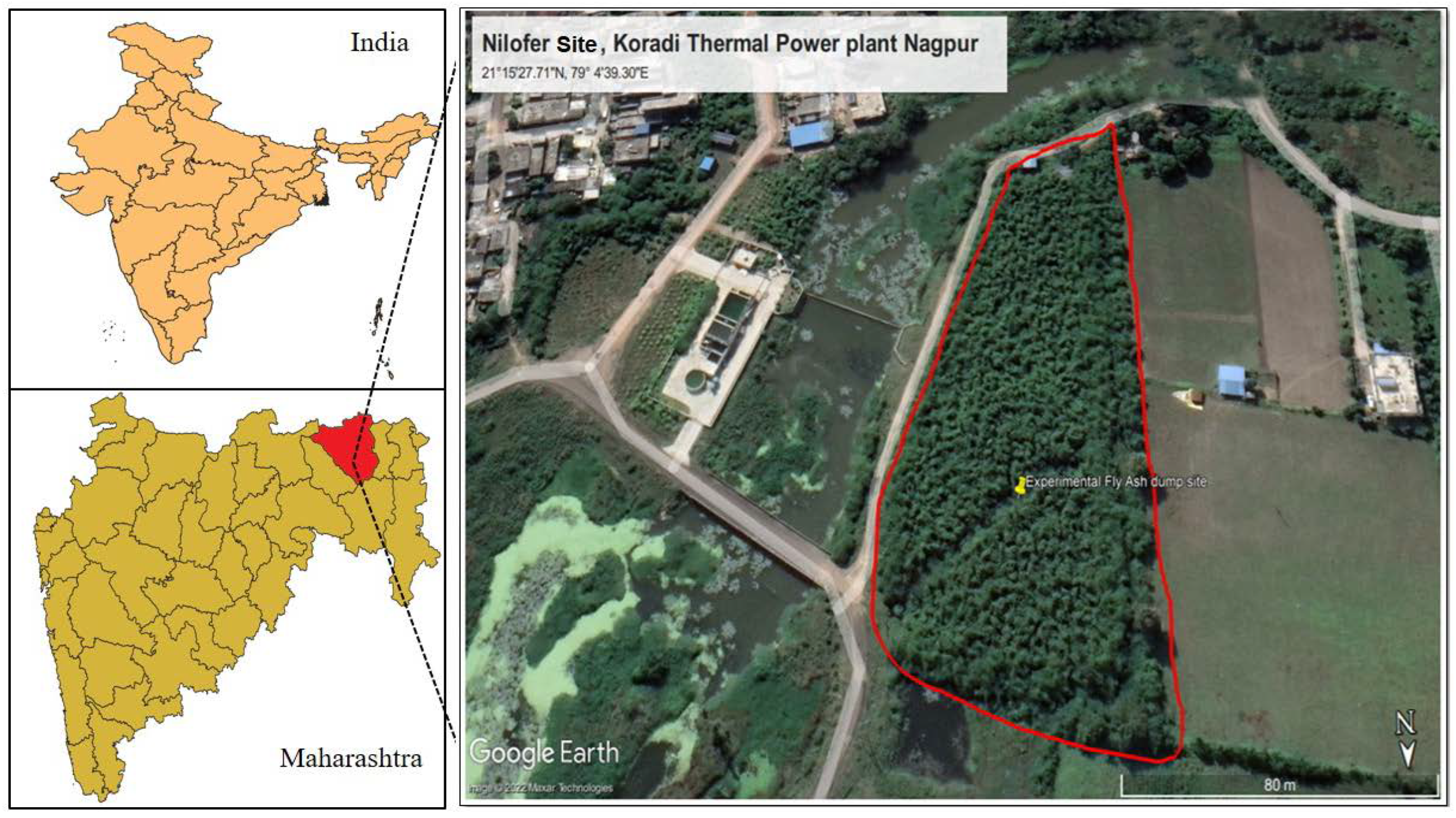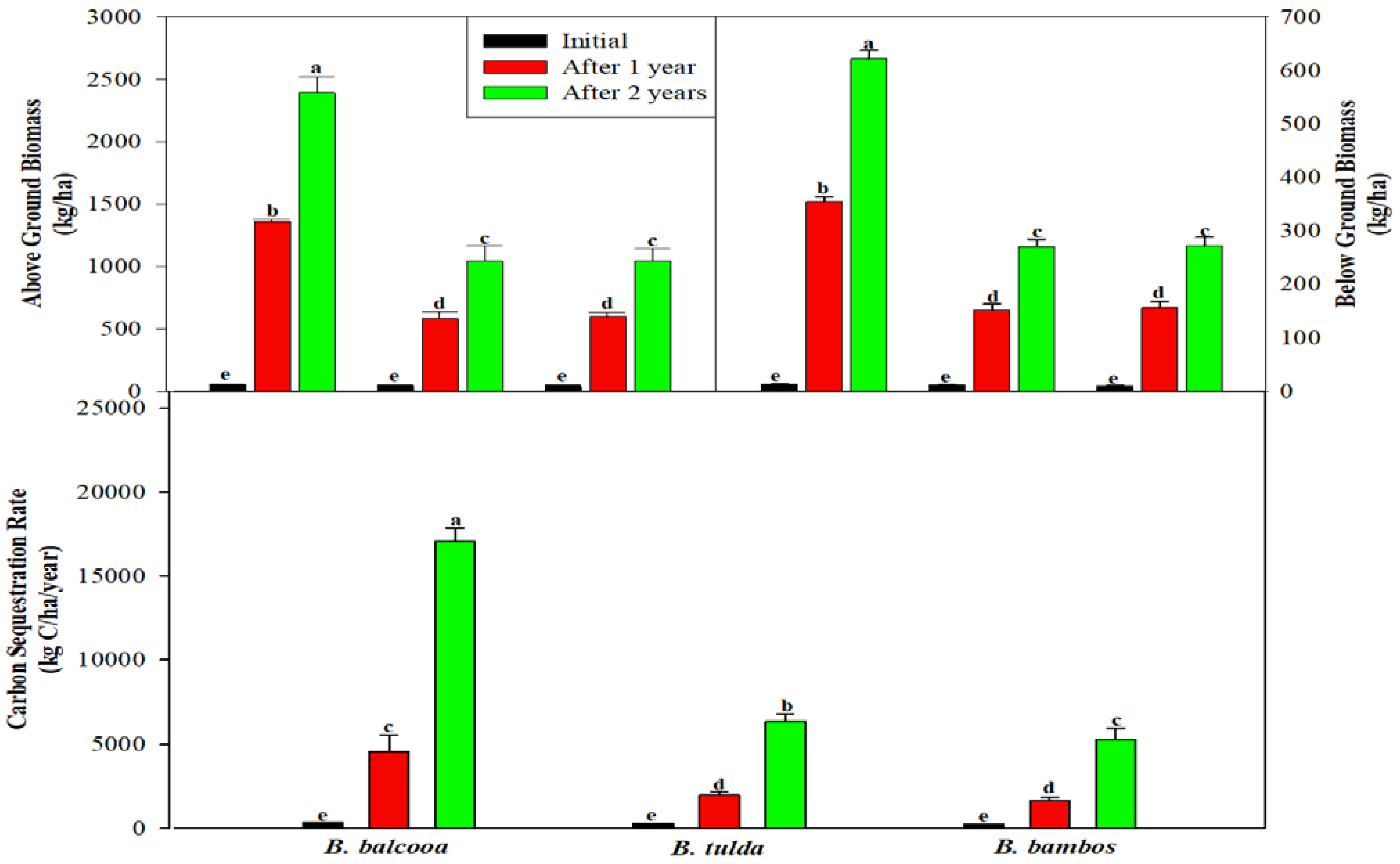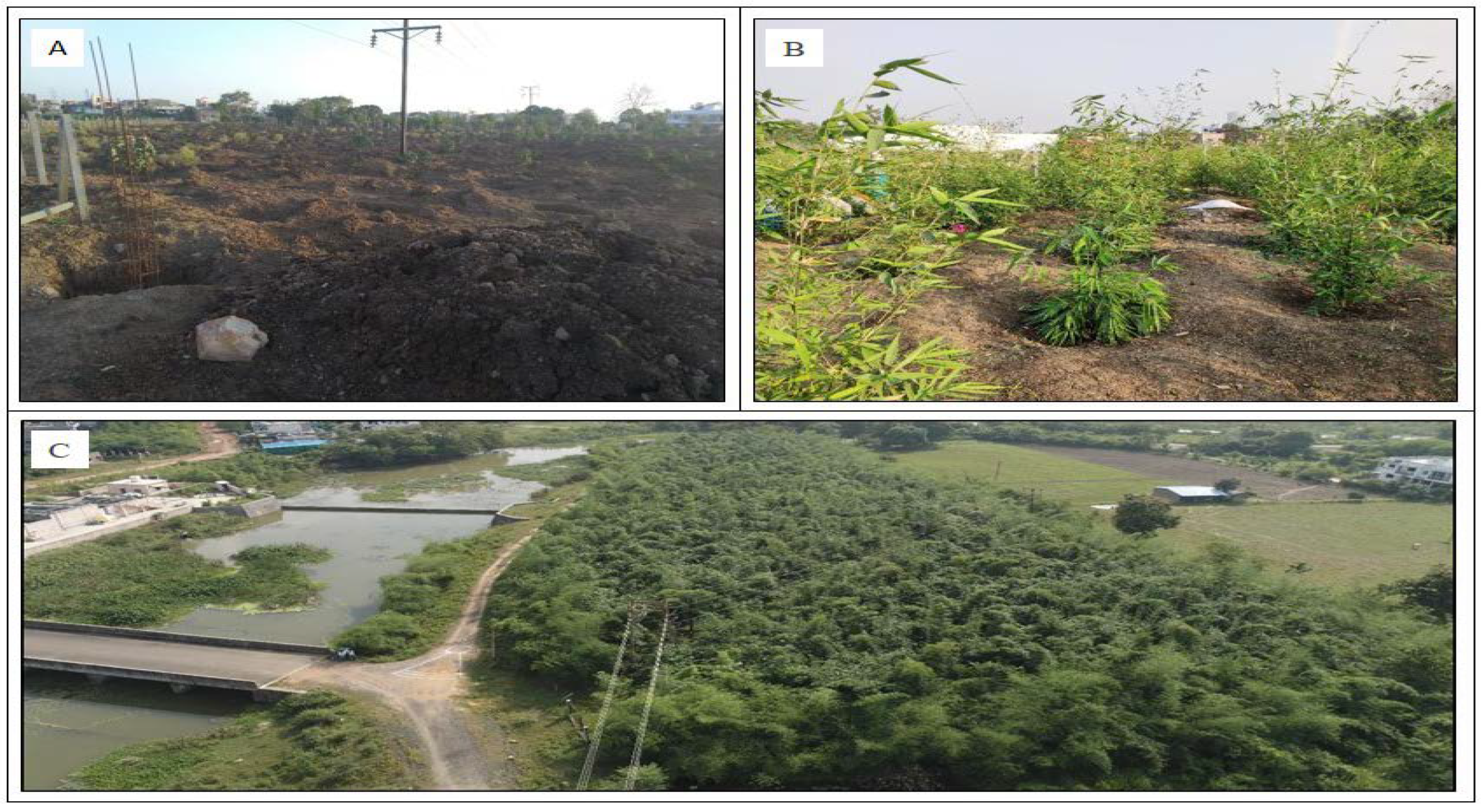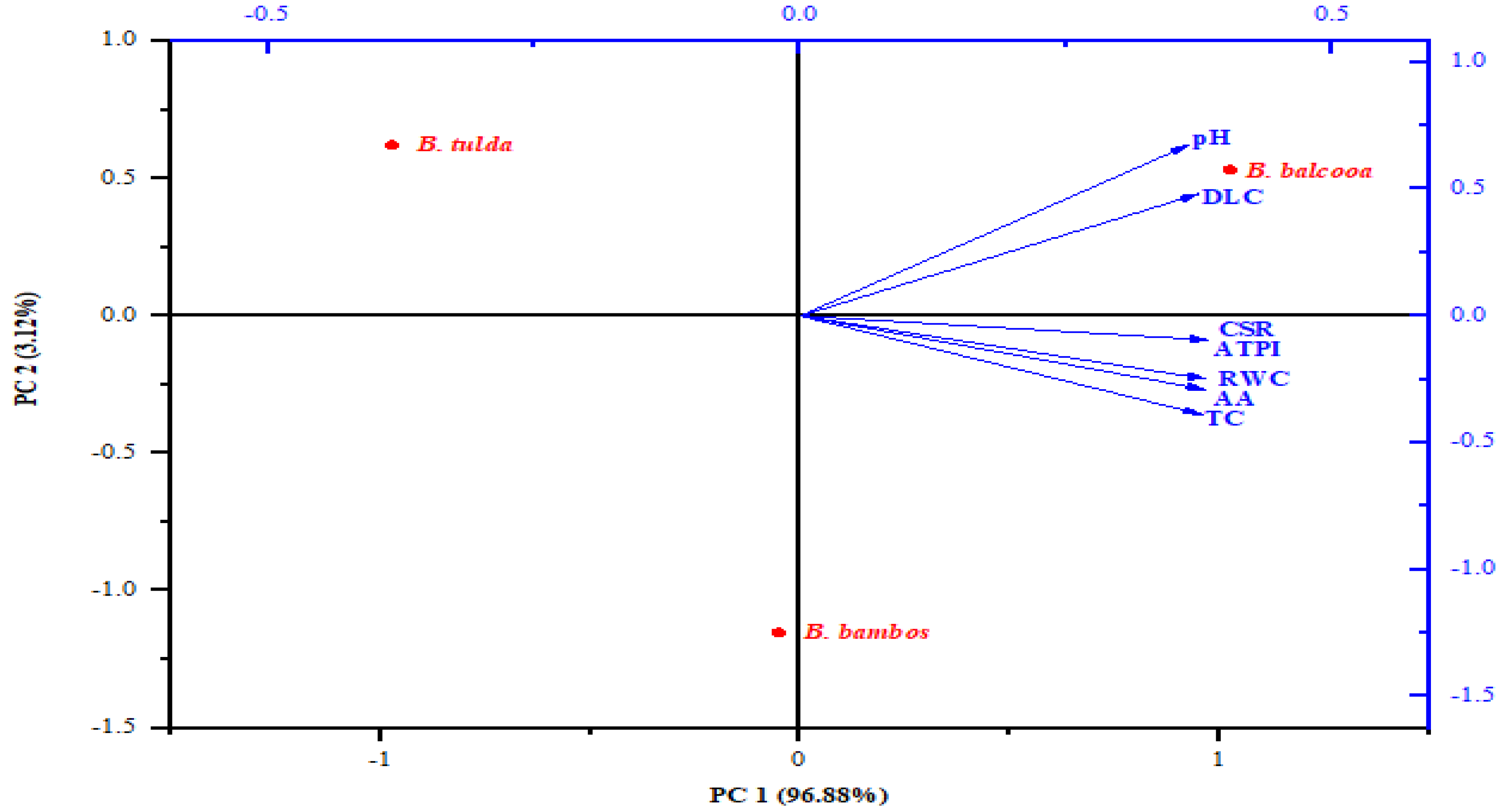Organic Wastes Augment the Eco-Restoration Potential of Bamboo Species on Fly Ash-Degraded Land: A Field Study
Abstract
1. Introduction
2. Materials and Methods
2.1. Study Area
2.2. Experimental Design and Sampling

2.3. Physicochemical Characteristics of Fly Ash Dumpsite Soil
2.3.1. pH and EC
2.3.2. Organic Carbon
2.3.3. Total and Available Nitrogen
2.3.4. Total and Available P
2.3.5. Total and Available K
2.3.6. Cation Exchange Capacity (CEC)
2.4. Determination of Heavy Metal Accumulation
2.5. Determination of Phytoremediation Indices
2.6. Determination of Plant Growth Rate in Bamboo Species
2.7. Determination of Biochemical Attributes in Bamboo Species
2.8. Determination of Air Pollution Tolerance Index (APTI) in Bamboo Species
2.9. Statistical Analysis
3. Results
3.1. Impact of FYM and Pressmud on the Physicochemical Attributes of FA Dumpsite
3.2. Impact of FYM and Pressmud on the Heavy Metal Content of FA Dumpsite
3.3. Impact of FYM and Pressmud on the Bioconcentration and Translocation Factor of Different Bamboo Species Grown of FA Dumpsite
3.4. Impact of FYM and Pressmud on the Plant Biomass and Carbon Sequestration Rate of Different Bamboo Species Grown on FA Dumpsite
3.5. Impact of FYM and Pressmud on the Photosynthetic Pigments of Different Bamboo Species Grown on FA Dumpsite
3.6. Impact of FYM and Pressmud on APTI of Different Bamboo Species Grown on FA Dumpsite
4. Discussion
5. Conclusions
Author Contributions
Funding
Institutional Review Board Statement
Informed Consent Statement
Data Availability Statement
Acknowledgments
Conflicts of Interest
References
- Sangita, K.; Prasad, B.; Udayabhanu, G. Synthesis of zeolite from waste fly ash by using different methods. Asian J. Chem. 2016, 28, 1435. [Google Scholar] [CrossRef]
- Shakeel, A.; Khan, A.A.; Upadhyay, S.K. Eco-friendly dual-edged management of fly ash and its antagonistic interplay with Meloidogyne incognita on beetroot (Beta vulgaris L.). Environ. Res. 2022, 209, 112767. [Google Scholar] [CrossRef] [PubMed]
- Ashraf, S.; Ahmad, S.R.; Ali, Q.; Ashraf, S.; Majid, M.; Zahir, Z.A. Acidified Cow Dung-Assisted Phytoextraction of Heavy Metals by Ryegrass from Contaminated Soil as an Eco-Efficient Technique. Sustainability 2022, 14, 15879. [Google Scholar] [CrossRef]
- Lizarraga-Mendiola, L.; Lopez-Leon, L.D.; Vazquez-Rodriguez, G.A. Municipal Solid Waste as a Substitute for Virgin Materials in the Construction Industry: A Review. Sustainability 2022, 14, 16343. [Google Scholar] [CrossRef]
- Reddy, G.K.; Sharma, S.H.K.; Jayasree, G.; Hussain, S.A.; Triveni, S.; Neelima, T.L. Assessment of spatial variability of soil fertility status of Nagarjuna Sagar Left Bank command area in Nalgonda district, Telangana using GIS-GPS. J. Pharm. Innov. 2021, 10, 481–489. [Google Scholar]
- Gupta, V.K.; Gupta, B.; Rastogi, A.; Agarwal, S.; Nayak, A. Pesticides removal from waste water by activated carbon prepared from waste rubber tire. Water Res. 2011, 45, 4047–4055. [Google Scholar] [CrossRef]
- Li, Q.; Guo, X.; Lu, Y.; Shan, G.; Huang, J. Impacts of adding FGDG on the abundance of nitrification and denitrification functional genes during dairy manure and sugarcane pressmud co-composting. Waste Manag. 2016, 56, 63–70. [Google Scholar] [CrossRef]
- Leo Daniel Amalraj, E.; Praveen Kumar, G.; Mir Hassan Ahmed, S.K.; Abdul, R.; Kishore, N. Microbiological analysis of panchagavya, vermicompost, and FYM and their effect on plant growth promotion of pigeon pea (Cajanus cajan L.) in India. Org. Agric. 2013, 3, 23–29. [Google Scholar] [CrossRef]
- Alamgir, M.; Kibria, M.G.; Islam, M. Effects of farm yard manure on cadmium and lead accumulation in Amaranth (Amaranthus oleracea L.). J. Soil Sci. Environ. 2011, 2, 237–240. [Google Scholar]
- Bian, F.; Zhong, Z.; Zhang, X.; Yang, C.; Gai, X. Bamboo-An untapped plant resource for the phytoremediation of heavy metal contaminated soils. Chemosphere 2020, 246, 125750. [Google Scholar] [CrossRef]
- Singh, S.; Karwadiya, J.; Srivastava, S.; Patra, P.K.; Venugopalan, V.P. Potential of indigenous plant species for phytoremediation of arsenic contaminated water and soil. Ecol. Eng. 2022, 175, 106476. [Google Scholar] [CrossRef]
- Rathour, R.; Kumar, H.; Prasad, K.; Anerao, P.; Kumar, M.; Kapley, A.; Singh, L. Multifunctional applications of bamboo crop beyond environmental management: An Indian prospective. Bioengineered 2022, 13, 8893–8914. [Google Scholar] [CrossRef] [PubMed]
- Piscitelli, L.; Bennani, Z.; El Chami, D.; Mondelli, D. A Circular Economy Model to Improve Phosphate Rock Fertiliser Using Agro-Food By-Products. Sustainability 2022, 14, 16228. [Google Scholar] [CrossRef]
- CEA (Central Electricity Authority), report on fly ash generation at coal/lignite based thermal power stations and its utilization in the country for the year 2020–21. Available online: https://cea.nic.in/wp-content/uploads/tcd/2022/08/Fly_ash_Generation_and_utilisation_Report_2021_22-1.pdf (accessed on 29 June 2022).
- Reynolds, S.G. The gravimetric method of soil moisture determination Part IA study of equipment, and methodological problems. J. Hydrol. 1970, 11, 258–273. [Google Scholar] [CrossRef]
- Viji, R.; Prasanna, P.R. Assessment of water holding capacity of major soil series of Lalgudi, Trichy, India. J. Environ. Res. Dev. 2012, 7, 393–398. [Google Scholar]
- Walkley, A.; Black, I.A. An examination of the Degtjareff method for determining soil organic matter, and a proposed modification of the chromic acid titration method. Soil Sci. 1934, 37, 29–38. [Google Scholar] [CrossRef]
- Kjeldahl, C. A new method for the determination of nitrogen in organic matter. Z. Anal. Chem. 1883, 22, 366. [Google Scholar] [CrossRef]
- Subbaiah, B.V.; Asija, G.L. A Rapid Procedure for the Estimation of Available Nitrogen in soils. Curr. Sci. 1956, 25, 259–260. [Google Scholar]
- Williams, J.D.H.; Syers, J.K.; Walker, T. Fractionation of soil inorganic phosphate by a modification of Chang and Jackson’s procedure. Soil Sci. Soc. Am. J. 1967, 31, 736–739. [Google Scholar] [CrossRef]
- Olsen, S.R. Estimation of Available Phosphorus in Soils by Extraction with Sodium Bicarbonate (No. 939); US Department of Agriculture: Washington, DC, USA, 1954. [Google Scholar]
- Schollenberger, C.J.; Simon, R.H. Determination of exchange capacity and exchangeable bases in soil-ammonium acetate method. Soil Sci. 1945, 59, 13–24. [Google Scholar] [CrossRef]
- Lorenz, P.; Meier, L.; Kahr, G. Determination of the cation exchange capacity (CEC) of clay minerals using the complexes of copper (II) ion with triethylenetetramine and tetraethylenepentamine. Clay Min. 1999, 47, 386–388. [Google Scholar]
- Sun, F.; Littlejohn, D.; Gibson, M.D. Ultrasonication extraction and solid phase extraction clean-up for determination of US EPA 16 priority pollutant polycyclic aromatic hydrocarbons in soils by reversed-phase liquid chromatography with ultraviolet absorption detection. Anal. Chim. Acta 1998, 364, 1–11. [Google Scholar] [CrossRef]
- Mohanty, M.; Patra, H.K. Phytoassessment of in situ weed diversity for their chromium distribution pattern and accumulation indices of abundant weeds at South Kaliapani chromite mining area with their phytoremediation prospective. Ecotoxicol. Environ. Saf. 2020, 194, 110399. [Google Scholar] [CrossRef]
- Pathak, V.; Tripathi, B.D.; Mishra, V.K. Evaluation of anticipated performance index of some tree species for green belt development to mitigate traffic generated noise. Urban For. Urban Green. 2011, 10, 61–66. [Google Scholar] [CrossRef]
- Maclachlan, S.; Zalik, S. Plastid structure, chlorophyll concentration, and free amino acid composition of a chlorophyll mutant of barley. Can. J. Bot. 1963, 41, 1053–1062. [Google Scholar] [CrossRef]
- Pittock, B.; Arthington, A.; Booth, T.; Cowell, P.; Hennessy, K.; Howden, M.; Woodruff, R. Climate Change: An Australian Guide to the Science and Potential Impacts; Australian Greenhouse Office: Canberra, Australlia, 2003. [Google Scholar]
- Mir, A.R.; Siddiqui, H.; Alam, P.; Hayat, S. Melatonin modulates photosynthesis, redox status, and elemental composition to promote growth of Brassica juncea—A dose-dependent effect. Protoplasma 2020, 257, 1685–1700. [Google Scholar] [CrossRef] [PubMed]
- Anake, W.U.; Bayode, F.O.; Jonathan, H.O.; Omonhinmin, C.A.; Odetunmibi, O.A.; Anake, T.A. Screening of Plant Species Response and Performance for Green Belt Development: Implications for Semi-Urban Ecosystem Restoration. Sustainability 2022, 14, 3968. [Google Scholar] [CrossRef]
- Kumar, R.; Thangaraju, M.M.; Kumar, M.; Thul, S.T.; Pandey, V.C.; Yadav, S.; Kumar, S. Ecological restoration of coal fly ash–dumped area through bamboo plantation. Environ. Sci. Pollut. Res. 2021, 28, 33416–33432. [Google Scholar] [CrossRef]
- Singh, S.K.; Rao, D.N.; Agrawal, M.; Pandey, J.; Naryan, D. Air pollution tolerance index of plants. J. Environ. Manag. 1991, 32, 45–55. [Google Scholar] [CrossRef]
- Zheng, J.G. Study on the dust-retention capacity resulting from greenbelt of the main roads in Xuchang. Adv. Mat. Res. 2013, 726, 1805–1808. [Google Scholar] [CrossRef]
- Khaliq, M.A.; James, B.; Chen, Y.H.; Saqib, H.S.A.; Li, H.H.; Jayasuriya, P.; Guo, W. Uptake, translocation, and accumulation of Cd and its interaction with mineral nutrients (Fe, Zn, Ni, Ca, Mg) in upland rice. Chemosphere 2019, 215, 916–924. [Google Scholar] [CrossRef]
- Danek, M.; Fang, X.; Tang, J.; Plonka, J.; Barchanska, H. Simultaneous determination of pesticides and their degradation products in potatoes by MSPD-LC-MS/MS. J. Food Compos. Anal. 2021, 104, 104129. [Google Scholar] [CrossRef]
- Karamina, H.; Fikrinda, W. Soil amendment impact to soil organic matter and physical properties on the three soil types after second corn cultivation. AIMS Agric. Food 2020, 5, 150–169. [Google Scholar]
- Meena, V.S.; Meena, M.K.; Meena, M.D.M.; Jat, R.S.; Choudhary, R.L.; Singh, H.; Rai, P.K. Improvement in growth and yield of Indian mustard by using micro and secondary nutrients fortified FYM in calcareous soil. J. Oilseed Brassica 2021, 12, 38–43. [Google Scholar]
- Singla, R.; Alex, T.C.; Kumar, R. On mechanical activation of glauconite: Physicochemical changes, alterations in cation exchange capacity and mechanisms. Powder Technol. 2020, 360, 337–351. [Google Scholar] [CrossRef]
- Kumar, A.; Bahadur, I.; Maurya, B.R.; Raghuwanshi, R.; Meena, V.S.; Singh, D.K.; Dixit, J. Does a plant growth-promoting rhizobacteria enhance agricultural sustainability? J. Pure Appl. Microbiol. 2015, 9, 715–724. [Google Scholar]
- Sabir, M.; Ali, A.; Zia-Ur-rehman, M.; Hakeem, K.R. Contrasting effects of farmyard manure (FYM) and compost for remediation of metal contaminated soil. Int. J. Phytoremediation 2015, 17, 613–621. [Google Scholar] [CrossRef]
- Chai, W.S.; Cheun, J.Y.; Kumar, P.S.; Mubashir, M.; Majeed, Z.; Banat, F.; Show, P.L. A review on conventional and novel materials towards heavy metal adsorption in wastewater treatment application. J. Clean. Prod. 2021, 296, 126589. [Google Scholar] [CrossRef]
- Shahid, M.; Shamshad, S.; Farooq, A.B.U.; Rafiq, M.; Khalid, S.; Dumat, C.; Niazi, N.K. Comparative effect of organic amendments on physio-biochemical traits of young and old bean leaves grown under cadmium stress: A multivariate analysis. Environ. Sci. Pollut. Res. 2019, 26, 11579–11590. [Google Scholar] [CrossRef]
- Nagar, M.C.; Dotaniya, M.L.; Sharma, A.; Dotaniya, C.K.; Doutaniya, R.K.; Saha, J.K. Pressmud overcome lead toxicity by improving spinach biomass in lead-contaminated soils. Environ. Monit. Assess. 2023, 195, 107. [Google Scholar] [CrossRef]
- Rathore, R.; Germaine, K.J.; Forristal, P.D.; Spink, J.; Dowling, D.N. Meta-omics approach to unravel the endophytic bacterial communities of Brassica napus and other agronomically important crops in response to agricultural practices. In Endophytes for a Growing World; Cambridge University Press: Cambridge, UK, 2019; p. 232. [Google Scholar]
- Yeasmin, S.; Assaduzzaman; Kabir, M.S.; Anwar, M.P.; Islam, A.K.M.M.; Hoque, T.S. Influence of Organic Amendments on Soil Carbon Sequestration Potential of Paddy Soils under Two Irrigation Regimes. Sustainability 2022, 14, 12369. [Google Scholar] [CrossRef]
- Diacono, M.; Montemurro, F. Effectiveness of organic wastes as fertilizers and amendments in salt-affected soils. Agriculture 2015, 5, 221–230. [Google Scholar] [CrossRef]
- Brar, B.S.; Singh, K.; Dheri, G.S. Carbon sequestration and soil carbon pools in a rice–wheat cropping system: Effect of long-term use of inorganic fertilizers and organic manure. Soil Till. Res. 2013, 128, 30–36. [Google Scholar] [CrossRef]
- Molnar, V.E.; Simon, E.; Tothmersz, B.; Ninsawat, S.; Szabo, S. Air pollution induced vegetation stress–the air pollution tolerance index as a quick tool for city health evaluation. Ecol. Indic. 2020, 113, 106234. [Google Scholar] [CrossRef]
- Goswami, G.; Panda, D.; Samanta, R.; Boro, R.C.; Modi, M.K.; Bujarbaruah, K.M.; Barooah, M. Bacillus megaterium adapts to acid stress condition through a network of genes: Insight from a genome-wide transcriptome analysis. Sci. Rep. 2018, 8, 16105. [Google Scholar] [PubMed]
- Bharti, S.K.; Trivedi, A.; Kumar, N. Air pollution tolerance index of plants growing near an industrial site. Urban Clim. 2018, 24, 820–829. [Google Scholar] [CrossRef]
- Lakshmi, U.R.; Srivastava, V.C.; Mall, I.D.; Lataye, D.H. Rice husk ash as an effective adsorbent: Evaluation of adsorptive characteristics for Indigo Carmine dye. J. Environ. Manag. 2009, 90, 710–720. [Google Scholar] [CrossRef]
- Gholami, A.; Mojiri, A.; Amini, H. Investigation of the Air Pollution Tolerance Index (APTI) using some plant species in Ahvaz region. Int. J. Plant Sci. 2016, 26, 475–480. [Google Scholar]
- Punit, S.; Rai, A. Evaluating Air Pollution Tolerance Index (APTI) of two plant species from industrial area of Jodhpur. Int. J. Energy Environ. Sci. 2021, 6, 11–15. [Google Scholar] [CrossRef]
- Yadav, V.K.; Singh, R.; Jha, R.K.; Kaushik, P. Biochemical variability of eggplant peel among Indian cultivars. Indian J. Biochem. Biophys. 2020, 57, 634–637. [Google Scholar]
- Joshi, N.; Bora, M.; Haridwar, U. Impact of air quality on physiological attributes of certain plants. Rep. Opin. 2011, 3, 42–47. [Google Scholar]





| Parameter | Before Plantation | After 2 Years Plantation | p-Value (p ≤ 0.05) |
|---|---|---|---|
| Physical characteristics | |||
| Moisture (%) | 2.76 ± 0.03 | 11.31 ± 1.67 | >0.001 |
| Bulk density (gm/cm3) | 1.42 ± 0.04 | 1.26 ± 0.07 | 0.011 |
| Porosity (%) | 60.2 ± 5.44 | 90.82 ± 4.86 | >0.001 |
| Water holding capacity (%) | 32.29 ± 1.05 | 54.91 ± 1.45 | >0.019 |
| Chemical characteristics | |||
| Ph | 7.95 ± 0.07 | 8.08 ± 0.13 | 0.066 |
| EC (µS/cm) | 105.77 ± 3.16 | 216.6 ± 13.62 | >0.001 |
| Organic carbon (%) | 0.18 ± 0.01 | 0.45 ± 0.09 | 0.011 |
| Organic matter (%) | 0.23 ± 0.08 | 0.78 ± 0.16 | 0.008 |
| Total N (mg/kg) | 214.67 ± 13.2 | 864.89 ± 45.21 | >0.001 |
| Available N (mg/kg) | 43.87 ± 3.96 | 110.13 ± 7.92 | >0.001 |
| Total P (mg/kg) | 143.07 ± 6.35 | 292.43 ± 16.6 | >0.001 |
| Available P (mg/kg) | 8.5 ± 1.26 | 33.1 ± 5.3 | >0.001 |
| Total K (mg/kg) | 2836.17 ± 104.89 | 4003.17 ± 179.1 | >0.001 |
| Available K (mg/kg) | 80.2 ± 3.78 | 380.98 ± 32.84 | >0.001 |
| Exchangeable cations (meq/100 gm) | |||
| Na | 1.76 ± 0.52 | 2.21 ± 0.43 | 0.103 |
| K | 1.97 ± 0.21 | 8.68 ± 1.35 | >0.001 |
| Ca | 2.64 ± 0.23 | 13.35 ± 1.79 | >0.001 |
| Mg | 1.93 ± 0 | 6.1 ± 1.2 | >0.001 |
| CEC | 6.98 ± 0.92 | 14.85 ± 1.21 | >0.001 |
| Elements | Before Plantation | After 2 Years of Plantation | p-Value (p ≤ 0.05) |
|---|---|---|---|
| Cu | 95.85 ± 1.63 | 72.55 ± 2.77 | >0.001 |
| Cr | 54.85 ± 3.46 | 27.48 ± 4.6 | >0.001 |
| Cd | ND | ND | ND |
| Ni | 70.35 ± 3.46 | 40.31 ± 1.15 | >0.001 |
| Mn | 1296.1 ± 16.97 | 908.49 ± 47.86 | >0.001 |
| Zn | 96.8 ± 0.57 | 69.38 ± 4.89 | >0.001 |
| Pb | 9.13 ± 0.32 | 6.06 ± 0.43 | >0.001 |
| Co | 45.25 ± 3.25 | 31.33 ± 3.58 | >0.003 |
| Ag | ND | ND | ND |
| Ba | 470.78 ± 8.03 | 232.49 ± 18.72 | >0.001 |
| Heavy Metals | |||||||||||
|---|---|---|---|---|---|---|---|---|---|---|---|
| Plant Samples | Cu | Cr | Cd | Ni | Mn | Zn | Pb | Co | Ag | Ba | |
| B. balcooa | BCF | 1.11 | 0.66 | 0.00 | 1.47 | 0.14 | 1.11 | 1.28 | 0.18 | 0.00 | 0.71 |
| TF | 0.40 | 0.51 | 0.00 | 0.19 | 0.19 | 0.30 | 0.01 | 0.00 | 0.00 | 0.06 | |
| B. bambos | BCF | 1.34 | 0.93 | 0.00 | 0.88 | 0.12 | 1.26 | 1.54 | 0.41 | 0.00 | 0.63 |
| TF | 0.34 | 0.57 | 0.00 | 0.60 | 0.11 | 0.24 | 0.02 | 0.01 | 0.00 | 0.14 | |
| B. tulda | BCF | 1.01 | 0.91 | 0.00 | 0.65 | 0.10 | 0.34 | 1.33 | 0.35 | 0.00 | 0.39 |
| TF | 0.54 | 1.13 | 0.00 | 0.88 | 0.26 | 1.05 | 0.02 | 0.02 | 0.00 | 0.47 | |
| Plant Sample | Ascorbic Acid (mg/100 g) | pH | Relative Water Content (%) | ATPI | Dust Retention Capacity (mg/cm2) |
|---|---|---|---|---|---|
| B. balcooa | 8.12 ± 0.79 a | 7.33 ± 0.12 a | 77.59 ± 2.51 a | 13.7 | 0.91 ± 0.02 a |
| B. bambos | 7.37 ± 0.36 a | 6.2 ± 0.1 b | 74.07 ± 6.42 a | 12.66 | 0.47 ± 0.01 b |
| B. tulda | 4.95 ± 0.09 b | 5.97 ± 0.06 c | 67.02 ± 7.65 b | 10.09 | 0.32 ± 0.01 c |
Disclaimer/Publisher’s Note: The statements, opinions and data contained in all publications are solely those of the individual author(s) and contributor(s) and not of MDPI and/or the editor(s). MDPI and/or the editor(s) disclaim responsibility for any injury to people or property resulting from any ideas, methods, instructions or products referred to in the content. |
© 2022 by the authors. Licensee MDPI, Basel, Switzerland. This article is an open access article distributed under the terms and conditions of the Creative Commons Attribution (CC BY) license (https://creativecommons.org/licenses/by/4.0/).
Share and Cite
Sawarkar, R.; Shakeel, A.; Kokate, P.A.; Singh, L. Organic Wastes Augment the Eco-Restoration Potential of Bamboo Species on Fly Ash-Degraded Land: A Field Study. Sustainability 2023, 15, 755. https://doi.org/10.3390/su15010755
Sawarkar R, Shakeel A, Kokate PA, Singh L. Organic Wastes Augment the Eco-Restoration Potential of Bamboo Species on Fly Ash-Degraded Land: A Field Study. Sustainability. 2023; 15(1):755. https://doi.org/10.3390/su15010755
Chicago/Turabian StyleSawarkar, Riya, Adnan Shakeel, Piyush A. Kokate, and Lal Singh. 2023. "Organic Wastes Augment the Eco-Restoration Potential of Bamboo Species on Fly Ash-Degraded Land: A Field Study" Sustainability 15, no. 1: 755. https://doi.org/10.3390/su15010755
APA StyleSawarkar, R., Shakeel, A., Kokate, P. A., & Singh, L. (2023). Organic Wastes Augment the Eco-Restoration Potential of Bamboo Species on Fly Ash-Degraded Land: A Field Study. Sustainability, 15(1), 755. https://doi.org/10.3390/su15010755







